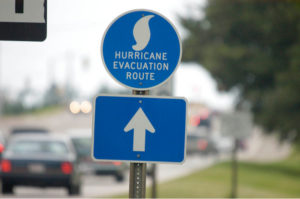Safe Places Report No. 2
It’s a natural human trait to put off difficult decisions until the last moment. And it’s not just due to laziness. Relocating to a Safe Place, for example, can be a difficult decision because jobs are more available in metropolitan areas, the kids don’t want to be pulled out of school, where their friends are, and there are the costs and logistics involved in any move to another home.
But I’m here to tell you it’s better to tackle this task sooner than too late. Look at this photo. It shows the procrastinators fleeing the Gulf of Mexico at the last moment before a hurricane hit, but it could be any city—your city—in any kind of major crisis.
How would you like to be one of those ants? Note that the expressway has become a one-way escape route, but it’s still so clogged it makes the usual evening rush hour look like a jaunt in the country. And what if you don’t have a full tank of gas…or even run out of gas in the middle of this mess? Your fellow escapees won’t be happy with you.
Take a Lesson from the Coronavirus Panic
When New York City became the hardest hit Covid-19 epicenter in the world, those who already had second homes fled like a swarm of locusts. The same was true of those who had relatives somewhere who would let them use their guest room for an indeterminable amount of time. This was especially true in the most affluent neighborhoods. I have friends on the Upper East Side of Manhattan and they told me is was like living in a ghost town. Surreal.
But not everyone was that lucky. What if you can’t get out before your local governmental dictators start enforcing quarantines and stay-in-place rules? What if the airlines and trains have shut down? And what if the community you plan to escape to no longer accepts refugees from the big city?
That’s exactly what happened during the Covid-19 panic.
An investigation by the New York Times revealed that an incredible 420,000 residents left New York City between March 1 and May 1. In the wealthiest neighborhoods more than 40% of residents had left. The city post office received 56,000 mail-forwarding requests in March and another 81,000 in April.
And where did they go? The greatest number of long-distance travelers headed for Miami or Los Angeles. For those staying closer to home, the flight was in all directions but the Hamptons at the eastern tip of Long Island were easily the most favored destination. No surprises anywhere there.
But what was a surprise was their frigid reception in some of those places, often spurred by fears that the city folks would bring the coronavirus with them. In the Catskill Mountains, Greene County reported that the first four confirmed coronavirus cases were all people from New York City. Other small outbreaks of the virus were reported in the Adirondacks, the Jersey Shore, and the Hamptons.
Florida ordered a 14-day quarantine on travelers from the New York area, and North Carolina’s Outer Banks barred the entry of all nonresidents. Massachusetts declared Nantucket and Martha’s Vineyard off-limits: “Stay on the mainland.”
New Jersey’s Gov. Philip D. Murphy authorized towns and counties to restrict or prohibit rentals at hotels, motels, and short-term lodgings. Boardwalks and beaches in some Jersey Shore towns were closed to outsiders and barricaded. A popular bumper sticker on cars in southern New Jersey read “Welcome to the shore. Now go home.” And police in Cape May were peppered with calls from residents reporting out-of-state license plates.
Locals in the Hamptons complained that the onslaught of refugees had emptied out grocery store shelves, and a liquor store clerk declared: “It’s like the Fourth of July out here.” The off-season population in Southampton soared in two weeks to nearly 100,000, up from 60,000. And in another direction—north of the city—residents of the Catskills were generally vitriolic: “Just because you have a second home up here doesn’t mean you have the right to put us at risk.”
Bear in mind that these are reactions to flights mostly by affluent New Yorkers. Imagine what the reaction would be to a different kind of panic led by poor and destitute people with no cash reserves or working credit cards.
The Lesson: Establish Your Roots Before the Next Crisis Hits
I learned that lesson in the 1960s during the exodus from burning East Coast cities. Karl Hess was a friend who had been a speechwriter for Senator Barry Goldwater but looked like a hippie. He found a haven in a town in West Virginia, of all places, that was a mecca for individualists like him.
You should find a community where you’re an easy fit, Karl advised, and move there as soon as possible and become an integral part of the town’s life. Karl was an excellent welder and earned the respect of his neighbors by his work helping to recreate a steamboat that had played a role in the town’s history. That was his way of fitting in, and you must find yours, whatever it is.
Just get there early and become as much of a “local” as possible (in some very traditional communities that’s measured in generations, not years). Most places are not that rigid, though, and you just want to make sure you’re inside when the barn doors are locked against outsiders.





